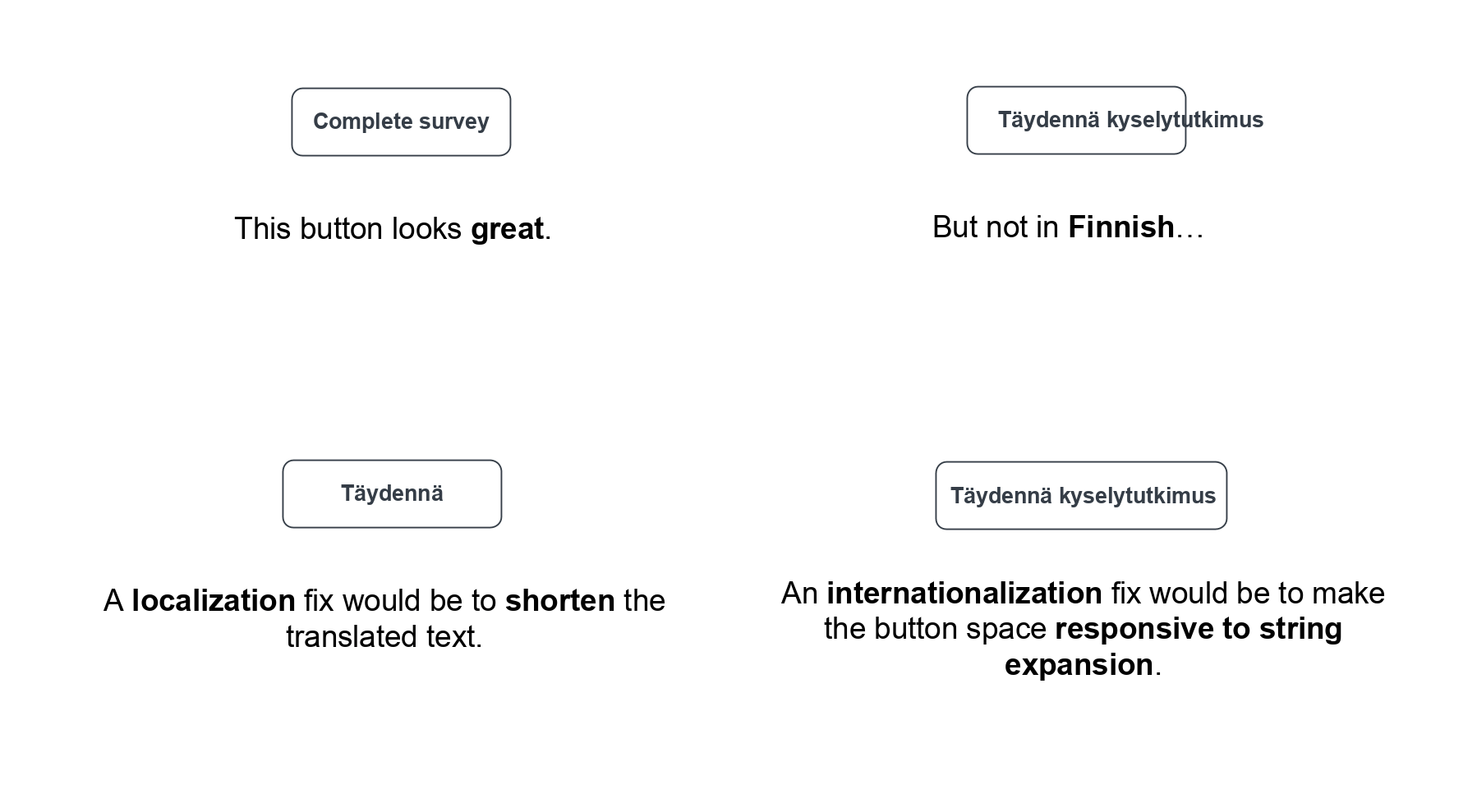全球 化 化
重點 (Top highlight)
Designing for a global audience can feel daunting. Do you localize your product? Or, do you internationalize your product? And what does that even entail?
為全球觀眾設計可能會令人生畏。 您是否將產品本地化? 還是您將產品國際化? 那甚至意味著什么?
Let’s demystify localization (L10n) and internationalization (I18n) to understand how designers might leverage both approaches to create truly global products.
讓我們揭開本地化(L10n)和國際化(I18n)的神秘面紗,以了解設計師如何利用這兩種方法來創建真正的全球產品。
Simply put, localization is translation plus cultural adaptation. International users are sensitive to cultural differences and are likely to distrust or overlook a product that poorly adapts to their market.
簡而言之,本地化是翻譯加上文化適應。 國際用戶對文化差異很敏感,可能會不信任或忽視適應其市場的產品。
Internationalization is about building features and experiences to programmatically adapt to the localized content and local market. If you aren’t coding and testing for internationalization, you risk giving your users a broken experience (E.g. the product may not be able to process payment correctly if the number format is not adapted to the country).
國際化是關于構建功能和體驗以編程方式適應本地化內容和本地市場。 如果您不進行國際化編碼和測試,則可能會給用戶帶來糟糕的體驗(例如,如果數字格式不適合該國家/地區,則該產品可能無法正確處理付款)。
Here are some examples of how a designer might use these different approaches.
這是設計人員如何使用這些不同方法的一些示例。

So which approach is the correct one for designers? Localization, internationalization, or a combination of both?
那么對于設計師來說哪種方法是正確的呢? 本地化,國際化,還是兩者結合?
Globalization (G11n) is the combination of localization and internationalization and it’s the proper approach for designing for a global audience.
全球化(G11n)是本地化和國際化的結合,是為全球受眾設計的正確方法。
SurveyMonkey如何應對全球化? (How does SurveyMonkey tackle Globalization?)
At SurveyMonkey we believe a truly global-ready product is one that has been internationalized by engineers and designers, and properly localized by qualified linguists.
在SurveyMonkey,我們相信一種真正面向全球的產品已被工程師和設計師國際化,并由合格的語言學家進行了適當的本地化。
We practice a simple schedule of continuous localization: translation happens every day and we edit Monday through Thursday. Translators, Lead Linguists, and Linguist Quality Assurance Specialists work directly via our Translation Management System (TMS) platform, and we do this across 15 locales.
我們制定了一個簡單的連續本地化時間表:翻譯每天進行,我們在周一至周四進行編輯。 翻譯人員,首席語言學家和語言學家質量保證專家直接通過我們的翻譯管理系統 (TMS)平臺工作,我們在15個地區中進行此項工作。
Additionally, designers and developers follow global-ready design practices. If you are designing for a global audience, you might want to consider implementing these 5 steps into your workflow.
此外,設計師和開發人員遵循全球就緒的設計慣例。 如果您是為全球受眾設計的,則可能需要考慮在工作流程中實施這5個步驟。
1.留出較長的語言空間 (1. Allow Space for Longer Languages)
English is a compact language (usually shorter than most latin-based languages). Designers should design for all languages upfront by allowing space for longer languages to expand. Here’s a simple rule of thumb: For less than 10 characters in English, allow up to a 300% expansion for other languages (I.e. Design for 30 characters).
英語是一種簡潔的語言(通常比大多數基于拉丁語的語言要短)。 設計師應通過為更長的語言留出空間來預先設計所有語言。 這是一條簡單的經驗法則:如果英文字符少于10個,則其他語言最多可擴展300%(即30個字符的設計)。
2.仔細平衡圖形與文本 (2. Carefully Balance Graphics with Text)
Graphics that have embedded English text in them can’t be translated, so creating a graphic without any text makes it applicable to any language.
嵌入了英語文本的圖形無法翻譯,因此創建沒有任何文本的圖形使其適用于任何語言。

Don’t go overboard. While removing all text sounds easy, sometimes taking out too much information makes the images hard to understand.
不要太過分。 盡管刪除所有文本聽起來很容易,但有時會花費太多信息,使圖像難以理解。
3.注意字體和格式 (3. Mind Your Fonts & Formatting)
Fonts do make a difference, especially for Asian languages. Anything under .50em (8pts) is very difficult to read in Chinese, Japanese, and Korean.
字體確實有所作為,特別是對于亞洲語言。 0.5em(8分)以下的任何內容都很難用中文,日文和韓文閱讀。
Additionally, don’t force capitalization or bold formats. Instead, work with your developer to put uppercase/bold/italic styling in the string itself and not the CSS template. This allows translators to apply formatting within the string based on the style rules of their unique language.
此外,請勿強行使用大寫或粗體格式。 而是與您的開發人員合作,將大寫/粗體/斜體樣式放置在字符串本身而不是CSS模板中。 這使翻譯人員可以根據其獨特語言的樣式規則在字符串中應用格式。
In screenshot above, all table column headers have been capitalized in the source code making it impossible for linguists to follow the proper capitalization rules in German.
在上面的屏幕截圖中,所有表列標題均已在源代碼中大寫,這使得語言學家無法遵循德語中正確的大寫規則。
4.設計日期/時間格式的差異 (4. Design for Differences in Date/Time Formats)
Most countries outside the USA use the 24-hour clock for displaying time and order months, days, and year differently. Instead of depending on translators to adjust these according to their language, consider having your developers implement calendar features using existing international libraries to automatically render the correct layout for each language.
美國以外的大多數國家/地區都使用24小時制來不同地顯示時間和訂單的月,日和年。 不要讓翻譯人員根據他們的語言來調整它們,而是考慮讓開發人員使用現有的國際庫來實現日歷功能,以自動為每種語言呈現正確的布局。
Fun fact: Not all dates are equal when it comes to a product launch. Which day is considered bad luck in Italy?
有趣的事實:關于產品發布,并非所有日期都相同。 在意大利哪一天算是運氣不好?
A) Friday the 17th
A)17日星期五
B) Friday the 13th
B)13日星期五
C) Friday the 7th
C)7日星期五
The answer is Friday the 17th!
答案是17日星期五!
This is an example of why it is important to get feedback from local office team members, users, and linguists working in-country. It helps you avoid the embarrassment of launching your product on this day in Italy.
這是為什么從本地工作團隊,用戶和語言學家那里獲得反饋很重要的示例。 它可以幫助您避免在意大利這一天發布產品的尷尬。
5.考慮文化敏感性 (5. Consider Cultural Sensitivities)
Using the same models for all regions could make local users feel less connected with your content. Make sure to use diverse people in accordance with the region. Use culturally relevant images when possible or neutral images when necessary.
在所有地區使用相同的模型可能會使本地用戶感覺與您的內容的聯系減少。 確保根據地區使用不同的人。 盡可能使用與文化相關的圖像,必要時使用中性圖像。
Another example where culturally relevant images are being used appropriately according to the target audience is shown below.
下面顯示了根據目標受眾適當使用文化相關圖像的另一個示例。

Besides imagery, color plays a factor as well. Enabling color adaptation can make an impact when reaching out to global audiences. For example, do you know what the color red means in China?
除了圖像之外,顏色也是一個因素。 啟用色彩適應功能可以影響到全球觀眾。 例如,您知道紅色在中國意味著什么嗎?
A) Peace and love
A)和平與愛
B) Danger
B)危險
C) Good luck and happiness
C)祝你好運和幸福
If you guessed ‘C,’ you are correct! Unlike in the United States, where the correct answer would be ‘B.’
如果您猜到“ C”,那么您是正確的! 與美國不同,正確答案是“ B”。
最后幾點提示 (A few final tips)
At SurveyMonkey, our designers use a Sketch plug-in that helps them preview layouts in several languages. The plug-in leverages existing translations and uses machine translation (MT) to simulate completely translated designs. Designers can catch text truncation, overlapping, and other user interface issues before all layouts are finalized.
在SurveyMonkey,我們的設計師使用了一個Sketch插件,可以幫助他們預覽幾種語言的布局。 該插件利用現有翻譯,并使用機器翻譯(MT)來模擬完全翻譯的設計。 在完成所有布局之前,設計人員可以解決文本截斷,重疊和其他用戶界面問題。
If you have a localization team, involve them in early design iterations. If you don’t have localization experts on your team, be sure to test your designs in German and Japanese before you start development. This will help you visualize your layout with text length that is much longer and shorter than English, as well as avoid a few headaches downstream.
如果您有本地化團隊,請讓他們參與早期的設計迭代。 如果您的團隊中沒有本地化專家,請確保在開始開發之前以德語和日語測試您的設計。 這將幫助您使用比英語長得多和短得多的文本長度來可視化您的布局,并避免在下游出現一些麻煩。
And always remember: languages are different, design for flexibility!
永遠記住:語言不同,設計靈活!
翻譯自: https://medium.com/curiosity-by-design/designing-for-globalization-572bc7d73af4
全球 化 化
本文來自互聯網用戶投稿,該文觀點僅代表作者本人,不代表本站立場。本站僅提供信息存儲空間服務,不擁有所有權,不承擔相關法律責任。 如若轉載,請注明出處:http://www.pswp.cn/news/274835.shtml 繁體地址,請注明出處:http://hk.pswp.cn/news/274835.shtml 英文地址,請注明出處:http://en.pswp.cn/news/274835.shtml
如若內容造成侵權/違法違規/事實不符,請聯系多彩編程網進行投訴反饋email:809451989@qq.com,一經查實,立即刪除!
)


精)








高級職位)





